Bolivia QRV in May 2024
The multi-operator CP7DX DXpedition from Bolivia is scheduled to be active until May 19. Chasers hoping to capture an ATNO or fill bands with this landlocked country in western-central South America will have an excellent opportunity on 160-6M in SSB, CW, FT4/FT8, and satellites (SSB and FM). The Argentinian operators will be employing a range of gear, including Icom transceivers (IC-9700 VHF/UHF/1.2 GHz and others), Yaesu and Elecraft rigs, and Ameritron amplifiers.
Bordered by Brazil to the north and east, Paraguay to the southeast, Argentina to the south, Chile to the southwest, and Peru to the west, Bolivia (officially the Plurinational State of Bolivia) has a population of close to 12.2 million and a total area of 424,164 square miles—larger than Texas (216,193 square miles) and smaller than Alaska (665,400 square miles). In August 1825, the country was named after Simón Bolívar, a Venezuelan leader in the Spanish American wars of independence.
Bolivia was ranked as the 186th Most Wanted DXCC Entity per Clublog as of April.
QSL Cards
The active hams at DX Engineering have had great success contacting Bolivia over the years (a good reason to contact them for help with your gear if you’d like to do the same). Here are a few of the QSL cards from their collections.
***
Wayne, K8FF, DX Engineering customer/technical support specialist, worked CP5EZ in January 1963.
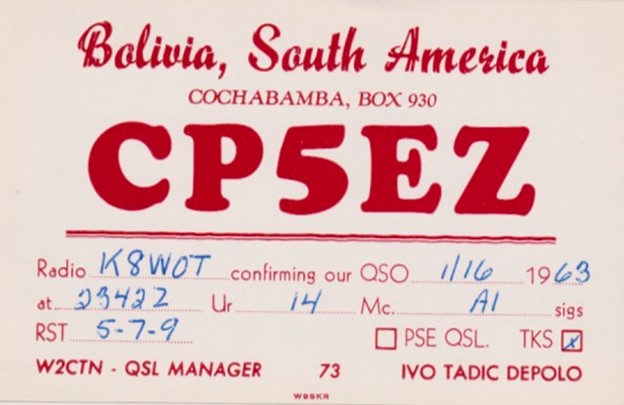
***
Tom, KB8UUZ, DX Engineering technical writer, received this card from CP8XA.
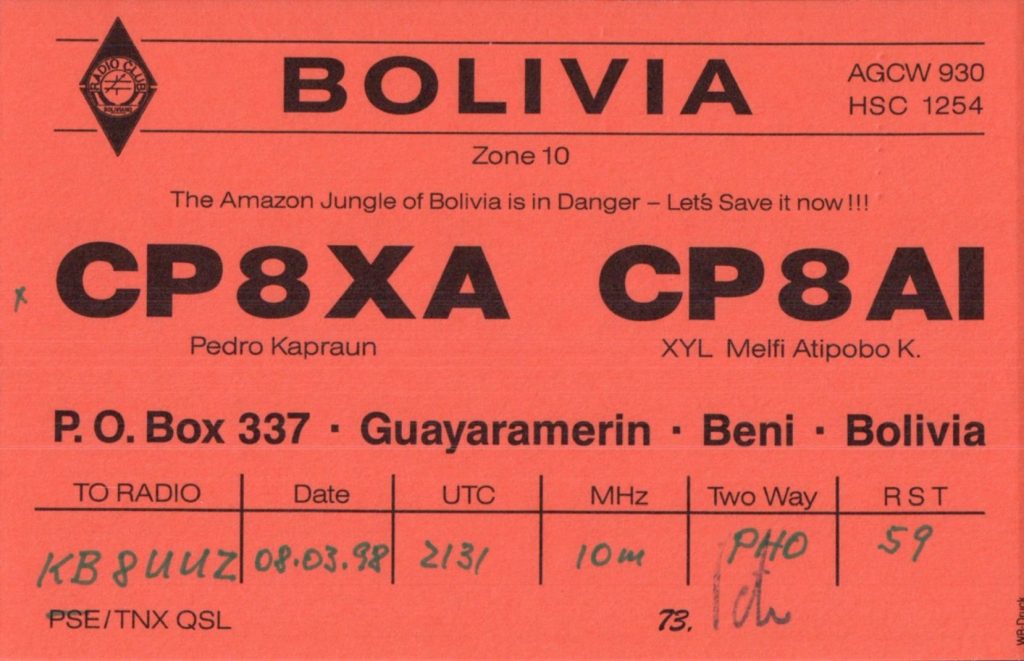
***
Dave, N8NB, DX Engineering customer/technical support specialist, received the QSL card below from CP4BT in March 2013. It features a llama—Bolivia’s national animal. There are more than three million llamas in Bolivia, accounting for over 60% of the world’s llama population. Like other members of the camel family in Bolivia (alpacas, guanacos, vicuñas), the llama plays a key role in the country’s economy and culture, as well as in the livelihoods of its inhabitants.
Tupiza, the QTH of the CP4BT DXpedition, is a town in southern Bolivia, where, according to historical accounts, American outlaws Butch Cassidy and the Sundance Kid passed through on their way to their deaths, glamorized in the Tinseltown depiction starring Robert Redford and Paul Newman.
Different from the guns-blazing, Hollywoodized shootout that ends the 1969 movie that bears their nicknames, it is believed the two men, cornered by Bolivian soldiers, died in 1908 in San Vicente, Bolivia, either during a gunfight or by self-inflicted wounds after being badly injured, as detailed in a March 2007 article in the Miami Herald.
Butch Cassidy (born Robert LeRoy Parker in Utah, 1866) and the Sundance Kid (born Harry Longabaugh in Pennsylvania, 1867) would meet up and become partners in crime, robbing several banks in the U.S. before fleeing to Argentina in 1901. While in South America, they bought a farm and went on the straight and narrow until 1905. The duo fled to Chile when authorities accused them of a robbery they apparently didn’t commit. “By 1908, they had turned up in Tupiza,” according to the article. Soldiers and civilians began hunting the pair after they robbed a mining company payroll. On November 6 they arrived in San Vicente, where a four-man posse barged into the adobe hut where they were lodging. Accounts differ as to what happened next, but historians agree that this was the spot where the bandits met their end.
Today, San Vicente (population of about 100 per a 2000 census) is “three to five hours by car over dirt roads from Tupiza, depending on whether sudden squalls turn dry creek beds into raging rivers,” according to the article. The town is home to a mining company and a Butch Cassidy and Sundance Kid museum.
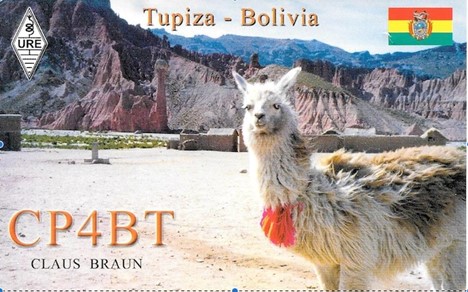
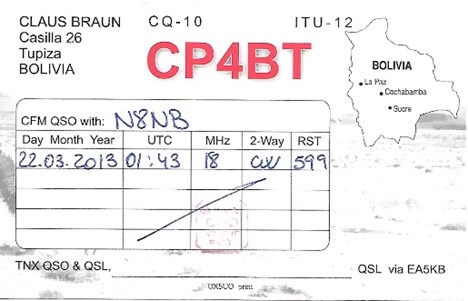
***
Dave, K8DV, DX Engineering customer/technical support specialist, reached CP1FF in May 2007 on 15M SSB. George, K3GP, customer/technical support specialist, contacted CP1FF in September 2000 on 15M RTTY.
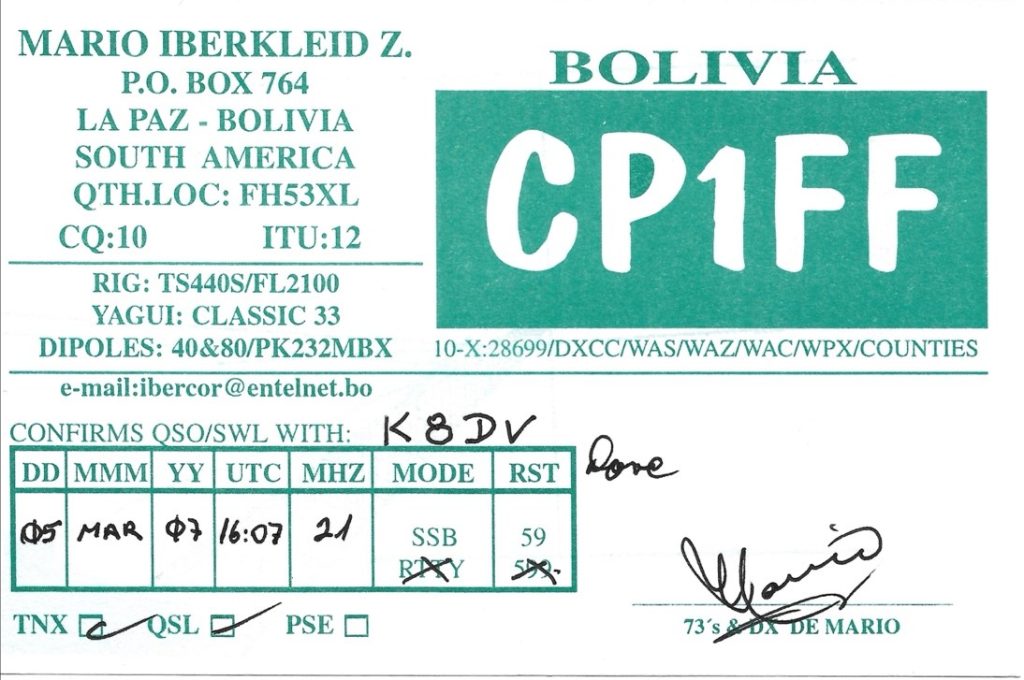
Want to upgrade your DXing capabilities? Find everything you need at DX Engineering, including transceivers, amplifiers, antennas, headsets, and more.
***
Editor’s Note: Every month, DX Engineering features QSL cards from our team members’ personal collections. To highlight upcoming DXpeditions, we’ll be displaying a few of our favorite cards along with details about what it took to make these contacts. We’re excited to share some of the special cards pulled from the thousands we’ve received over the years. We look forward to seeing your cards as well!

